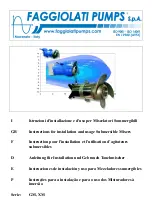
24
THE MONO MIX
- The
GL4000
includes an independent
mix buss for the M (mono) output. Each channel and group
can be routed direct to this buss by pressing the related
M
routing switch. The signal is sourced pre PAN control so that
the mono mix is not affected when the stereo mix image is
adjusted. The M output can be a different mix to LR. If you
want the mono output to be the sum of the L and R mix then
use the
L(R) TO MONO
controls to mix L and R to M.
Some typical applications of the Mono output:
Centre speaker feed
- To fill out the sound between
the left and right speakers. This is usually positioned
to benefit the audience nearest the stage.
Mono PA system
- Here, the L and R mix can be used
as additional subgroups or for a separate stereo
recording.
Sub bass feed
- To drive a speaker designed to
reproduce the very low frequency sounds in multi
speaker systems.
MATRIX SENDS FROM MONO
- The mono buss signal
may be mixed into matrix A to D by adjusting the matrix send
controls. The signal is sourced pre or post the M fader by
selecting the
POST/PRE
switch.
MONO MASTER
- The M mix is controlled using a 100mm
fader. As with the groups and LR: automated
MUTE
, a pre
fade mix meter, matrix sends, insert and
AFL
are available.
STAGE MONITOR MODE
- Unique to Allen & Heath
consoles, an underpanel mode switch determines how the
Mono section operates. In the normal up position it provides
a conventional mono buss output for front-of-house
applications as described above.
When pressed, the Mono section is reconfigured as the
stage monitor engineers listen wedge control. The Mono
output becomes silent until an AFL or PFL is selected.
Pressing PFL automatically overrides any selected AFL.
The Mono section AFL switch is disabled in monitor mode.
Pressing AFL monitors the output post insert and post fader.
You can hear the effect of any EQ or signal processing
inserted into the outputs. The listen monitor is controlled
using the 100mm MONO fader with MUTE switch.
Connect the Mono output to an amplifier driving the engineers
monitor speaker. It is best to use a speaker identical to those
used for the stage monitors, usually wedge shaped (hence
the term listen 'wedge'). You would not normally plug an EQ
into the listen monitor as it is best to hear the selected listen
source exactly as the performer hears it on stage.
Pressing TALK dims the listen output by 20dB to prevent
possible acoustic feedback between the local speaker and
talkback mic.
Содержание GL4000
Страница 1: ...ALLEN HEATH GL4000 Dual Function Audio Mixing Console USER GUIDE PUBLICATION AP2642...
Страница 10: ...9 SYSTEM DIAGRAM...
Страница 45: ...44 FRONT OF HOUSE WITH RECORDING...
Страница 54: ...53...
















































